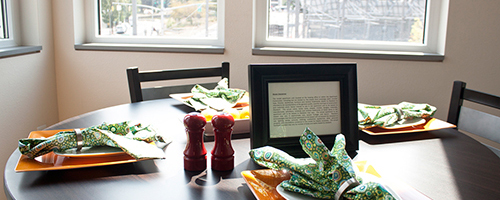Portland State, a 49-acre urban campus that bleeds into the surrounding metropolis, sits nestled in the heart of downtown. Blurring the boundaries between school and city, PSU is more than buildings of bricks and mortar: It is a product of community birthed in conflict and tempered in challenge. From humble beginnings to sprawling urban university, PSU’s roots reach back through decades of opposition, beginning with a world at war.
The college that can’t stop
[portfolio_slideshow id=55028]
Portland State, a 49-acre urban campus that bleeds into the surrounding metropolis, sits nestled in the heart of downtown. Blurring the boundaries between school and city, PSU is more than buildings of bricks and mortar: It is a product of community birthed in conflict and tempered in challenge. From humble beginnings to sprawling urban university, PSU’s roots reach back through decades of opposition, beginning with a world at war.
The beginning
With the United States’ entry into World War II, the production of war materials became a major priority. As the country scrambled to produce equipment for the war effort, Oregon became a leader in the production of ships. Henry Kaiser’s Portland shipyards became a focal point of U.S. shipbuilding. Between 1940 and 1943, defense employment numbers in the region skyrocketed from just a few thousand to 140,000. The demand for workers was so high that local recruitment rapidly depleted the hiring pool. People were imported by the thousands from as far away as New York City to work in the shipyards.
With the influx of newcomers, Portland soon found that it was unable to house the hordes of workers and families entering the city. The housing industry entered crisis mode as people without homes found themselves sleeping in tents, in movie theaters and on the streets. Fear spread throughout the Kaiser Company that ship production would inevitably be hindered by the lack of housing. Vanport was the solution.
The housing project of Vanport—unofficially known as Kaiserville—was 650 acres at what is now Delta Park in North Portland. Vanport quickly became a hub of transient labor, making it the second-largest city in Oregon and home to more than 42,000 people. It was a city that never slept. Shipbuilding was a 24-hour enterprise, and life at Vanport revolved around work. Both father and mother worked, so children were generally left unattended and unsupervised. Housing was rapidly and poorly constructed so heat and electricity was at times scarce and problematic.
As the war came to a close, residents trickled away from the makeshift town. Many would leave after the need for ships waned, but waves of incoming veterans seeking to reintegrate into civilian life through work and education would keep the population steady at 18,000. In 1946, the Oregon State System of Higher Education approved plans to create a temporary education program, the Vanport Extension Center, to serve WWII veterans and their families.
Classes were first held as a short-term summer program, designed to prepare students transferring to accredited universities like Oregon State University and the University of Oregon. That first summer there were 221 enrolled students, almost entirely veterans. By fall quarter, enrollment had jumped to 1,410.
Vanport College evolved rapidly. Engineering was the most common course of study, followed closely by business and the liberal arts. Students moved quickly to form a student government, as well as a host of clubs. The college even had its own newspaper, Vet’s Extended—which would be retitled the Vanguard that winter—edited by blind student and veteran Don Carlo.
The flood
All came to a crashing halt on Memorial Day, 1948. The Columbia River, swollen from melted snowpacks and copious amounts of rainfall, smashed a hole in a railroad embankment that had been serving as a dike; the result was a 10-foot wall of water that plowed its way through Vanport. Cars bobbed atop the surface of the river as houses were uprooted from their foundations and carried away with the current. The majority of the residents were able to evacuate in time, but 15 lives were lost.
Engulfed in its watery grave, Vanport was beyond saving. President Harry Truman flew in to witness the aftermath firsthand. What he encountered was decimation. No reconstruction effort was to be attempted; Oregon’s second-largest city had been erased from the map.
A new beginning
Fortunately, the spirit of Vanport College survived the flood, but the institution was left without a home. Quick-thinking administrators and faculty members had salvaged some equipment and records from the school before evacuating, giving it a second chance at life. The displaced place of higher learning would wander among temporary homes for several years before finding a new permanent location.
By 1952, Vanport College had moved three times, finally resting at the old Lincoln High School (the modern-day Lincoln Hall) at Portland’s Park Blocks. There, at the “Old Main,” the school would shed its former title, renaming itself Portland State College, signifying the school’s expansion into a four-year-degree-issuing institution.
During the 1950s and ’60s, Portland State flourished in an era of relative peace and prosperity defined by growth. Enrollment numbers increased and the school was ignited by a fury of expansion that spread throughout the Park Blocks and saw greater numbers of students, faculty, courses and buildings, culminating in the 1969 Oregon State Board of Higher Education decision to give Portland State university status.
Unrest
Then, in an instant, all that tranquility was washed away in a flood of protest and discontent. It was 1970 and the United States was in the midst of an armed conflict in Vietnam. On April 30, President Richard Nixon gave a televised speech to the world in which he announced plans to deploy American forces to Cambodia, where North Vietnamese forces were supposedly being harbored. The antiwar movement got its second wind.
Handfuls of students and faculty members had begun to organize protests and sit-ins following the president’s announcement, but PSU’s social activism would reach new heights in the wake of the events at Kent State University in Ohio on May 4. After protestors burned down the Reserve Officers’ Training Corps building during antiwar demonstrations at the campus, the National Guard was sent in to establish order. Guardsmen, nervous about the crowds, first fired tear gas on the protestors—and then opened fire, killing nine and wounding four.
Universities around the nation responded with one of the loudest movements of student protest to date: 350 universities—PSU included—were shut down by millions of students in solidarity with the victims of the Kent State massacre. Protestors barricaded the South Park Blocks, which at the time were still open for traffic, staging acts of civil disobedience in the form of demonstrations, marches and speeches. By May 11, Portland State protestors had been on strike for nearly a week and classes had been cancelled. At the center of the Park Blocks sat a large medical tent, which would soon become an icon of the school’s protest.
Portland police clad in riot gear and armed with nightsticks entered the park to disperse the crowds, remove the barricades and tents, and return a sense of order to the campus. The armored enforcers encountered students, arms locked, surrounding the first-aid tent. When they refused to budge, violence erupted. Protestors and police clashed in a bloody dispute that sent 31 protestors to the hospital. The next day, thousands of PSU students and local Portlanders united to march on City Hall in outrage over the use of excessive police force. Neither the mayor nor the police commissioner came out to meet
the crowd.
The rest of the term went by without any major conflicts. The protest had ended, but the legacy lived on. The events at the medical tent sent tremors throughout PSU that succeeded in radicalizing a new wave of students, faculty and community members alike.
Bigger than the flood
The smoke had cleared over the campus, but decades of budget crisis loomed on the horizon. Perhaps the most significant challenge PSU faced since the tidal waves of the Columbia River was the lack of funding and the state’s unwillingness to fully financially support its universities. With decreasing amounts of public money entering the school, budget cuts were common and the threat of layoffs and program cuts was imminent. By 1992, the financial crisis was considered one of the most threatening issues the school had faced. By March of 1993, 25 people had been laid off, including eight tenure-track faculty members.
In the midst of financial crisis, PSU managed to persevere and incorporate a broader scope of programs: women’s studies in 1970, the School of Urban Affairs in 1976, the School of Performing Arts and the College of Liberal Arts and Sciences in 1982, to name just a few.
A new mission statement was drafted in 1978, one that put a focus on the metropolitan area surrounding the school. There would be an emphasis on off-campus education that provided research and other services to the city—the embodiment of the motto immortalized on the walls of the university: “Let Knowledge Serve the City.”
In 1993, Portland State implemented one of the most radical changes to the undergraduate system to date: the University Studies program. Designed to create a more dynamic and effective general education structure, University Studies has become the centerpiece of PSU’s undergraduate program. Intended to provide opportunities for greater learning that extend through all four years of the program, it culminates in a Senior Capstone that brings together students from various majors to create a project that in some way benefits the community.
Looking to the future
Entering the new millennium, PSU began to revamp itself to fully commit to ensuring a sustainable future. The Campus Sustainability Office was founded in 2002, followed shortly by the Social Sustainability Colloquium in 2003. A groundbreaking policy requiring all new construction to achieve Leadership in Energy and Environmental Design certification was put into effect. All buildings would become “green”; new buildings would be designed specifically to minimize their impact on the environment through the conservation of energy, water and natural resources, and major renovations of existing campus buildings would soon commence in the attempt to reduce the campus’ ecological footprint.
In the midst of unparalleled growth, the university is now looking to the future. With 30,000 students, PSU is the largest university in Oregon. It is projected that the number will grow to 50,000 by 2035. To accommodate this expansion, PSU’s latest efforts have focused on an urban renewal project aimed at transforming Portland’s downtown. Recently given the green light by Portland’s City Council, the project will create a 144-acre education district with PSU at the center. Millions of dollars will go toward redesigning and restoring the district to give the school room to grow. Over the next 30 years, urban renewal revenue will be used to expand university programs, fund new buildings and projects and upgrade pre-existing ones in great need of attention. In an ever-growing city, the hope is to provide a more stable environment and a more secure future for the college that can’t stop.






